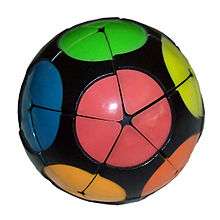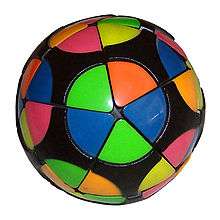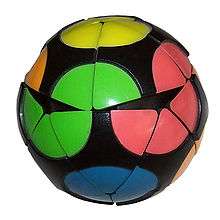Impossiball



The Impossiball is a rounded icosahedral puzzle similar to the Rubik's Cube. It has a total of 20 movable pieces to rearrange, same as the Rubik's Cube, but all of the Impossiball's pieces are corners, like the Pocket Cube.
History
William O. Gustafson applied for a patent for the Impossiball design in 1981 and it was issued in 1984.[1] Uwe Mèffert eventually bought the rights to some of the patents and continues to sell it in his puzzle shop under the Impossiball moniker.
Description
The Impossiball is made in the shape of an icosahedron that has been rounded out to a sphere, and has 20 pieces, all of them corners. The puzzle has twelve circles located at the vertices of the icosahedron, and opposite circles are the same color. Because of the rounded shape of the puzzle, the pieces move up and down as they are rotated. It is also possible to remove one piece, turning the puzzle into a spherical version of the 15 puzzle.
The purpose of the puzzle is to scramble the colors, and then restore it to its original state of having one color per circle. This puzzle is equivalent to solving just the corners of a Megaminx. The original Impossiball had the same colors as the Rubik's Cube: red, orange, yellow, green, blue and white. Meffert currently produces two versions, one with six colors and one with twelve. The six-color version (pictured) uses pink, two shades of orange, yellow, green and blue. All the pieces are still distinguishable, however, because the two pieces with the same three colors are mirror images of each other. The twelve-color version has red, pink, orange, yellow, two shades of green, three shades of blue, purple, brown and white.
Solutions
In spite of its daunting appearance and greater number of possible positions, the Impossiball is not much more difficult than the standard 2×2×2 Pocket Cube. This is because it is not a deep-cut puzzle; it only has pentagonal face layers which are similar in structure to the square face layers of the cube. There are no pieces that do not have a counterpart on the cube. Many of the techniques employed in the solution of the Pocket Cube can also be adapted for the Impossiball.
Number of combinations
There are 20!/2 ways to arrange the pieces, since there is no way to create odd permutations without tampering with the puzzle. There are 319 ways to orient the pieces, since the orientation of the last depends on that of the preceding ones. Since the Impossiball has no fixed face centers, this result is divided by 60. There are 60 possible positions and orientations of the first corner, but all are equivalent because of the lack of face centers.
The entire number is 23 563 902 142 421 896 679 424 000 (roughly 23.6 septillion on the short scale or 23.6 quadrillion on the long scale).
See also
References
External links
- Meffert's puzzle shop
- Jaap's Impossiball page — contains solutions and other information